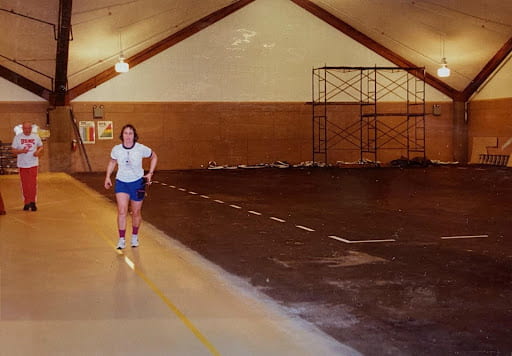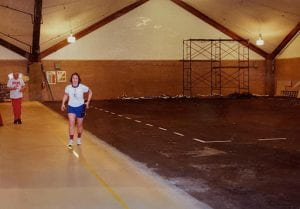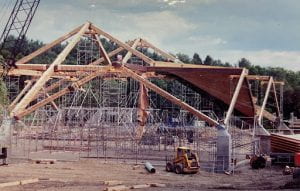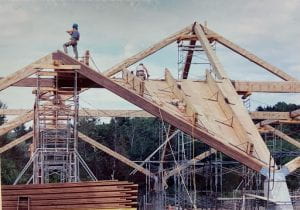
Dec 16, 2021 | Exclusive, Feature, News, Sports, TopStory |
By Michael Levesque, assistant editor and staff writer
This spring marks the 30th anniversary since the Fitness and Recreation Center (FRC) opened its doors to UMF and the community.
Since the building’s first official day on April 27, 1991, a lot has changed. Among these changes are the students and community members who use it, the staff who keep the building functioning, and the equipment inside. Noticeably missing from that list is the building itself. The Fitness and Recreation Center today greatly resembles the building that was made almost 30 years ago. “This office here used to have lockers where the group fitness instructors would change but it also had the director, the assistant director and the administrative assistant,” says Linda Blodgett as she gestures around the room her office is in. Blodgett has been working at the university since 1989. In 2001 she moved from the business office, where she started, to the FRC. “I was in the business office, it didn’t look like it does now,” said Blodgett. “Coming down here was much more comfortable for me – I haven’t regretted it. I have been on this campus for 32 years and I just love working down here.”
The familiar sight of the FRC has created an intimate atmosphere that many students and community members have come to value. “What I love the most is the sense of team camaraderie,” said Danny Terhune, a student and Physical Education instructor at the FRC. “[I love] the staff as a whole, you truly feel seen.”
“We’re such a unique facility, where the community comes in here and it’s really kind of neat,” Blodgett added. “Our staff that works here gets to know the community members and they see them outside of this place and our community members are always greeting them. It makes the students feel at home. It’s really really nice.”
Since the building’s erection in 1991, the building has adapted to the fitness and recreation needs of the community members. One year after the building was first opened to the public, the pool was installed. “Fitness is always evolving,” says Blodgett. “Body building was big back then. Group fitness was [also] really popular. Now it’s evolving into strength training.”
In order to meet the ever changing needs of the members of the community, constant work and refinement is done to the equipment within the FRC – with a cost as well. “There’s a lot of challenges,”says Blodgett, “the price of equipment is going up…[as well as] the maintenance of it. The cost of maintaining this equipment is a lot. There’s not a lot of companies around here that maintain equipment.” The COVID-19 pandemic has also contributed to the challenges at the FRC. “Trying to keep our membership up [is a challenge]. Our outside members, not just the students… are huge,” Blodgett says.
Even as the challenges continue, many in the community still treasure the building and the community with it. “I hope this place stays here forever,” says Blodgett. “I just hope that UMF… realizes how much this facility means to the people – students and community members… I hope it stays for the next 30 years because it is a great facility and it’s great for our students… You know, our students that work here learn so much about dealing with the public, it gets their confidence up. A lot of our graduates that work here say they haven’t found a facility they like more than here.”
“I love how I get to share my love of fitness with these coworkers as well as students in my class,” Terhune says. “This helps me as an education major really practice my skills as a teacher outside of my normal classes.”
Ben White, Director of Fitness and Recreation at the FRC, was pleased to announce some of the celebrations for the 30th anniversary coming in the spring. “A canoe race, mountain bike race, and 5k run” are all scheduled for the spring, according to White. As of right now these activities are scheduled for April 30th, 2022 – three days after the official 30th anniversary day. A reception will also be held later than afternoon. “The hope is that we get as many alumni back that we can that have worked here or that have gone to school here. I know a lot of alumni that went to school here that have never stepped foot in the building,” Blodgett says.
More details about the celebration in April are expected to be released on the FRC Instagram and Facebook pages as well as through their newsletter. The front desk at the FRC can be contacted at (207)-778-7495.

Community members inside the FRC prior to the completion of a basketball court. Photo courtesy of Linda Blodgett.



Construction on the Fitness and Recreation Center building. Photo courtesy of Linda Blodgett.
Feb 15, 2019 | News |
By Avery Ryan Contributing Writer
This January the Fitness and Recreation Center (FRC) adjusted its community group fitness classes to the classification system used by the University’s PHE-010 courses.
The transition to the “Phase” system follows three years after its implementation in the PHE classes. Previous to phases, the mandatory PHE class was separated into specific forms of exercise, including Play Fit, Aquatics, Strength & Conditioning, and Cardiovascular Fitness.
This separation saw mixed success until Assistant Director Alison Thayer “had an epiphany during one of [her] personal training courses.” Thayer, the Director of Fitness and PHE Coordinator, found inspiration in the American Council of Exercise’s separation of fitness into four phases and adjusted these categories to better fit PHE.
The result was a separation of PHE into three phases:
- Phase 1: Designed for the entry-level exerciser, Phase 1 is intended for those with little to no fitness experience.
- Phase 2: A middle-level fitness group. Participants in this group are familiar with some forms of exercise but still retain some unfamiliarity or need additional instruction.
- Phase 3: This phase is intended for those who are familiar with most types of exercise. These are your high school athletes and passionate fitness enthusiasts.
The phases also did away with specific categories of fitness interest. Instead of having to choose between Play Fit and Aquatics, for example, students would be exposed to all options of fitness in one form or another through their time in PHE. “I wanted the students to have a more well-rounded experience,” said Thayer. Group Fitness Coordinator Mike Colella added, “It gives students the opportunity to say where they are in their own fitness.”
This change to phases has also impacted instructors at the FRC. The phases require that instructors have a more holistic understanding of fitness and are better trained and prepared for diverse exercise experiences. “Instructors need a larger toolbox and an open attitude,” said Thayer, “We found that [they] are communicating more and requesting for guest instructors more often.” Thayer has found that this change has been successful, emphasizing greater consistency in fitness familiarity inside of individual classes— allowing for a stronger sense of camaraderie through PHE.
Starting in January all group fitness classes are being adjusted to the phases that PHE recently adopted. Thayer detailed, “We are trying to put similar PHE standards on the community members.” The group fitness schedule now labels its classes according to the PHE phases and includes descriptions on what the phases mean. Thayer emphasized that these labels are suggestions and that part of being a fitness instructor is being prepared to make modifications for members with different levels of fitness experience.
In labeling classes according to these classifications, Colella was surprised. “[We had] the realization that we didn’t have enough entry-level classes.” Colella continued excitedly, “Now we have at least one [Phase One class] six out of seven days a week.”
Thayer echoed this excitement, “Our goal is to get anybody who has ever wanted to attend a group fitness class the opportunity to do so.” Thayer also hopes that these changes will make the group fitness classes more accessible for UMF students.
Thayer also emphasized how this change has allowed for her PHE instructors to transition into becoming group fitness instructors. Instructors are better prepared and gain experience across multiple fields of exercise. Thayer concluded, “We are part of an educational institution, and our mission is education— for our student instructors and students alike.”
The group fitness schedule is available on the Fitness and Recreation Center’s page on the University website and is available in paper in the lobby of the FRC.
Feb 16, 2018 | News |
By Dale J Rappaneau Jr Contributing Writer
Transfer students, regardless of age or background, are currently required to fulfill UMF’s mandatory PHE course in order to graduate, which has some transfer students feeling frustrated and marginalized.
Andrea Swiedom, a 26-year-old Creative Writing major who commutes an hour to and from UMF, says she was told during enrollment that the PHE course was not required for transfer students. “When my advisor, Jeff [Thomson], told me it was required, I thought he must have had it wrong,” said Swiedom. “I thought it was a joke or that Jeff didn’t know, because I remember being told transfer students didn’t have to take it.”
Swiedom added, “I think the requirement makes sense for younger students who don’t have a good routine established or get too nervous to get into the gym, but common sense should be implemented into the system.”
Michael J Angelides, transfer counselor for UMF, said when he works with transfer students who are concerned about PHE, he tells them it is a “required class for all students” and “a great way to force some students out of their comfort zone and get them familiar and comfortable with the FRC.” He added that, in the past, “it’s entirely possible that I didn’t grasp the requirement for transfers and misrepresented the requirement to some of them early in my role as transfer counselor.”
Alison Thayer, coordinator of first-year collegiate physical fitness, stands behind the college’s requirement for all students, traditional and transfer alike, to take the mandatory PHE course. “Even transfers will benefit with becoming familiar with the Fitness and Recreation Center,” she said. “They’ll get to know others who exercise, maybe find a study partner—and being active benefits everyone, regardless of age.” Thayer later added, “ I can certainly see how the PHE course could be stressful for the person who commutes, has kids, and a full-time job. I understand a 30-year-old isn’t going to want to be in a class with 20-year-olds, which is why we try to be flexible, just come to me and let’s talk.”
Part of that flexibility is being demonstrated during this semester by students like Swiedom, who are fulfilling their PHE requirement through a Mainely Outdoors learn-to-ski program. “That’s a totally new idea,” said Thayer, who credited adjunct professor Scott Hoisington for spearheading the program’s implementation. “They take about twenty or thirty students and twice a week they learn to ski on Titcomb, with a third day attending the regular PHE class. We want our students to learn physical activity skills that they’ll take with them after graduation, and this is one example.”
Although appreciative that the learn-to-ski program is fulfilling the PHE requirement, Swiedom said she “would have learned to ski regardless of the PHE credit,” and still feels the requirement for transfers to take the PHE course is less beneficial and more “bureaucratic nonsense.” Thayer, on the other hand, is thankful for having taken the PHE course when she attended UMF, for it inspired her to learn how to cross-country ski, a passion she still enjoys today.




